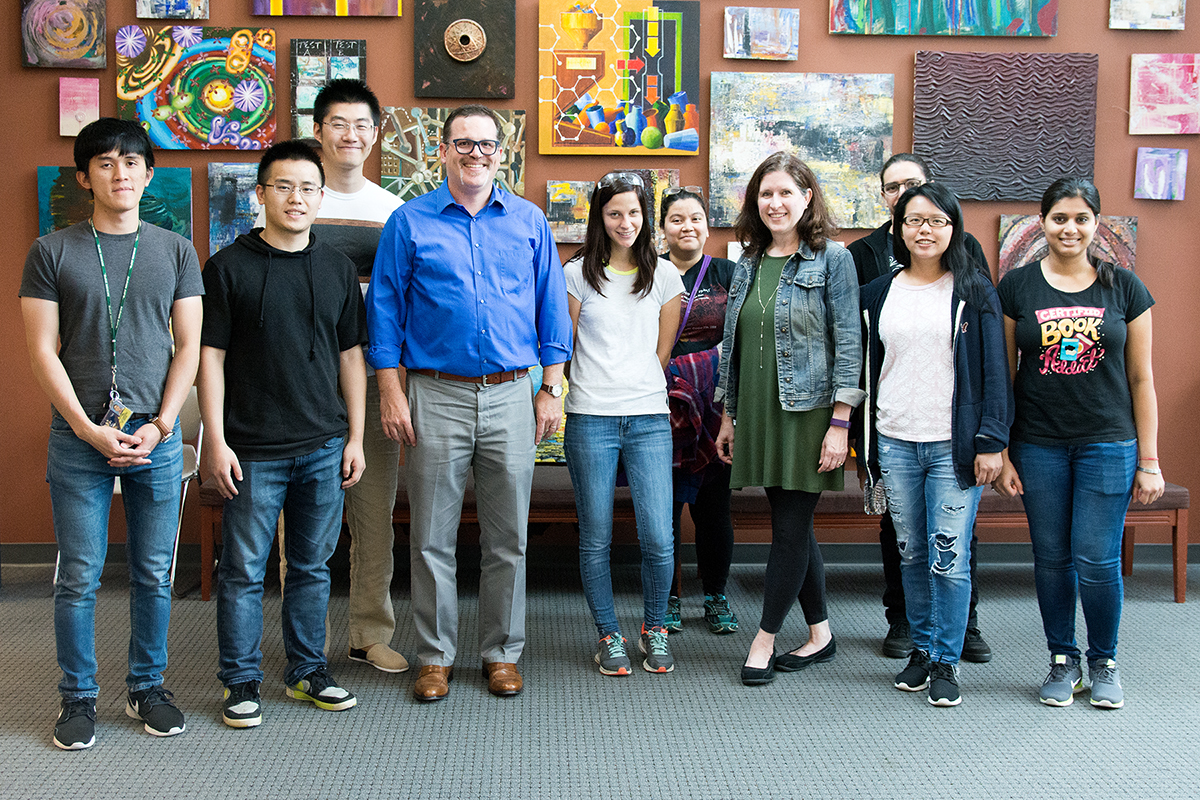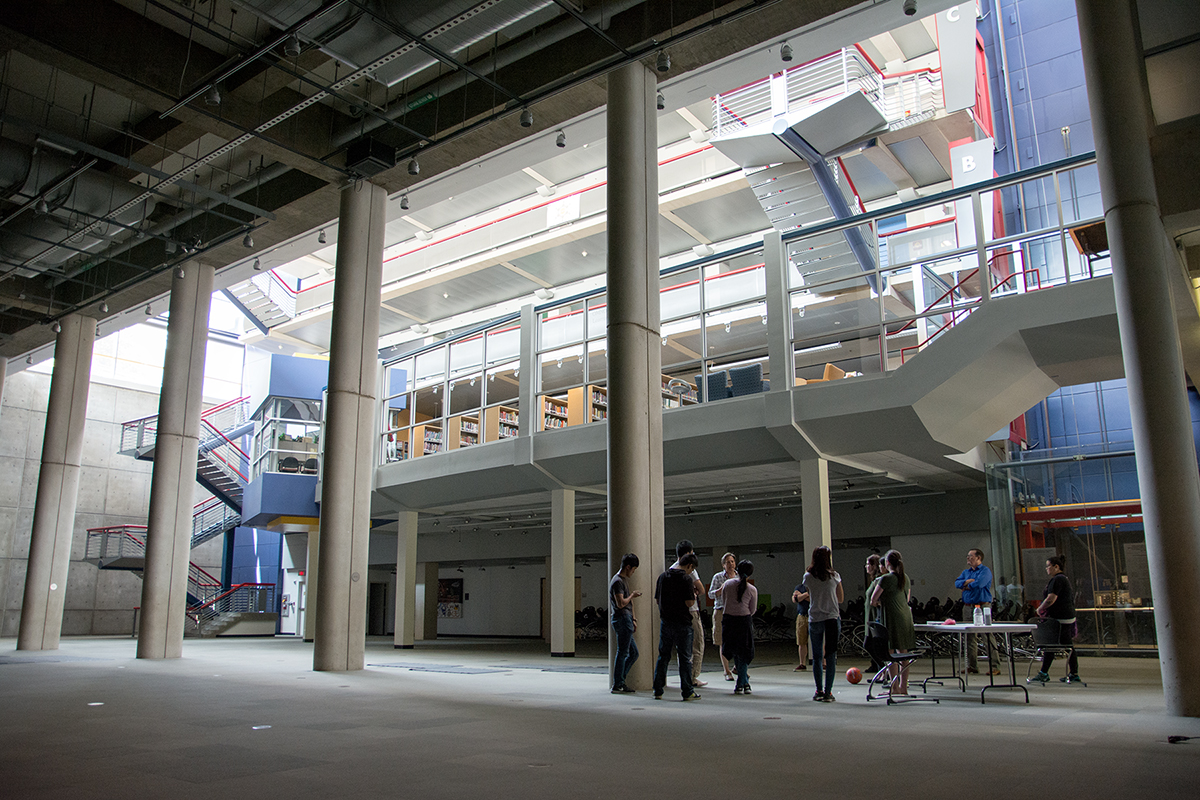RET Students Learn New Ways of Teaching at Akron’s STEM Middle School
What type of school do teachers dream of working for? What is your idea of the ideal teaching job?
The University of Akron has had a partnership with The National Inventors Hall of Fame STEM Middle School, a place that aims to teach and to learn differently, since its inception. It is one of many important partnerships the school maintains to promote STEM education. On the afternoon of August 10th the College of Polymer Science and Polymer Engineering facilitated a tour of the middle school for grad students and teachers participating in the Research Experience for Teachers (RET) program.
One of the best parts of programs like RET is the variety of trips and sources that provide valuable expertise and experiences. This trip was organized by Dr. Lynne Pachnowski, a LJFFCOE Professor who had held sessions with RET discussing the best teaching practices. If RET grad students wanted to witness a unique method of teaching, NIHF STEM Middle School was a great place to start.
The school opened for operation in 2009, although its founders began preparations for the school all the way back in 2004. Before they even began construction, educators and architects teamed up to a design a building that would be most conducive to creative learning. With the help of many experts, including a Disney Imagineer, they designed and built a place where kids could learn through experience, rather than just absorbing what they are told.
The environment is different from most public schools in many ways. The whole building is very colorful and geometric, including a glass library with no ceiling and a glass elevator with clear panels that show off the electric board (aptly named the “Willy Wonka Elevator”). The building’s infrastructure was left exposed in safe places so that kids could observe how things work, sparking questions and conversations between students and educators. Walls move in order to combine or separate classrooms, and desks are designed specifically to be reconfigured into shapes for group work. Experiences at this school are able to be highly individualized, which is very important when dealing with students of varying skill levels.
While it is a designated STEM school licensed by the state of Ohio, NIHF STEM Middle School is open to the public. Admissions are run like a lottery, which essentially means that kids in each district have an equal chance of being admitted as long as they sign up to be considered. There are no pre-entrance academic screenings and no pay-to-play. This method works for any child, even those with a history of bad behavior, bad grades, or kids who live in poverty. This model allows for a very diverse student body, which is representative of the district’s population.
Of course with a diverse student body of about 400 kids, teachers are bound to encounter some challenges. Most schools decide to ‘teach to the middle,’ moving along at a pace that will challenge students that are falling behind while boring the kids at the top of the class. Like everything else it does, the STEM school’s approach is different; instead of teaching to the middle, they simple look for one years’ worth of progress from each individual, regardless of where they started out.
All of this was relayed to RET grad students by “Coach” Sam Crews, Hub Manager for the Ohio STEM Learning Network Akron Hub and a science teacher who had helped to design and found the school. Crews has been an educator for over 20 years, and he knows exactly how special NIHF STEM Middle School is.
Crews said that when he first started teaching, he was doing it the same way he had been taught. But when he started teaching math at the STEM school, kids were “not just learning how, they were learning why, and that’s incredibly important in math.”
Crews, who is now teaching science, said that “we reinvent everything here, including titles.” That is why he is not called a teacher. Instead, he is ‘Coach Crews.’ Libraries are actually learning cabins, and the librarians are media specialists. Students are not students at all- they are called learners. And they do a lot of learning thanks to the robust programs at the STEM school.
NIHF STEM Middle School offers courses in technology competency, cooking, robotics, math, science, foreign languages, and even has a great art program. Kids who study there can earn high school credit, helping them graduate even faster. They are taught, or ‘coached,’ through problem-based learning, where they are presented with a problem and they must come up with a solution. They can present their findings to their classmates and even local companies who can come to the school to commission creative problem-solving. Kids at the school have come up with amazing ideas through this framework, such as painting city crosswalks to indicate that there is art nearby, or creating a Google extension that is able to use specific criteria to identify ‘fake news.’
Not every solution will work just right the first time, and Coach Crews assures us that that’s okay. “You have to take risks, and sometimes they won’t work,” he explained. He quoted A. P. J. Abdul Kalam: “A fail is just a first attempt in learning.”
At the end of the tour, RET grad students walked away with a new image of what education could look like in their minds. RET is all about finding different ways to teach and learn, and this experience was a perfect example of that.
“Every student will leave as a great communicator, a problem solver, a collaborator. If you make them good at those things, they’re going to be fine,” Crews said.
Problem solving and collaborating is a great framework for learning, which is why The University of Akron is proud to have been one of the founding partners that made this educational experience a reality for so many kids.
Trips like this one are a fun, engaging way to support our students in making connections with people in their field of interest. The College of Polymer Science and Polymer Engineering is happy to have been able to provide this opportunity for RET participants to engage and connect with others in the educational community.




